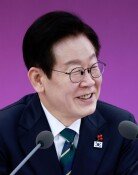[Opinion] Jongro Intersection and Times Square
[Opinion] Jongro Intersection and Times Square
Posted January. 16, 2005 22:10,
Korean New Year is first greeted at the Jongro intersection. Once the Boshingak Bell rings into the dark, the eyes and ears of 100,000 people in the crowd and several million TV viewers concentrate on this moment. This is the moment when all become one, saying goodbye to the passing year with a sense of loss, and greeting the new one with hope. Then, as a person who visits a long forgotten house for the holidays, I am suddenly reminded of the presence of this intersection located north of the river, a land that lost the race against the southern area of the river and was mistreated due to Seoulphobia.
Americas New Year starts at New Yorks Times Square, Manhattans five-way crossing where Broadway and 7th Avenue intersect. A lighted glass ball comes down from the former New York Times building in the midst of countdowns coming from the several hundred thousand people gathered there. At the end of the countdown, champagne bottles are burst open and kisses are exchanged. There are no New Year addresses from venerable seniors, like we have here. A wild street party takes place all night instead.
The details and the stage may differ, but when greeting the New Year, people from both sides get a taste of an intense moment in which time and space, or individual and community, become one. This is a rare experience for modern man. Modern people, who are addicted to speed, change and mobility, understand objects as a passenger on a moving train would. Places are nothing but blurry scenes passing by outside the window, and urban space is merely real estate that is evaluated by its unit value. However, in this collective initiation ceremony, the static quality of space emphasizes the fluidity of time, and the fluidity of time enhances the placeness of space.
Even in the digital age, it is topical to select a traditional location as a stage on which to greet the New Year. The information revolution promotes spatial dispersion, but at the same time, brings back people and money to the neglected downtown area, revitalizing it. Times Square has switched from a population center of commoners to a commercial area of the elite. The area around Jongro is the site of colossal redevelopment projects. However as it can be seen through New Yorks example, there is a big cold shadow behind the downtown revitalization. Jobs for the middle class are decreasing and income rates are polarizing. I hope the government will not be dazzled by the light of development, neglecting the shadow it creates.
Kang Hong-bin, Guest Editorial Writer, professor at the University of Seoul, hongbinkang@hotmail.com







